Our Favorite Hotels in Osaka
• 5-star: Ritz-Carlton
• 4-star: The Leben
• 3-star: The Flag
• Cheap: The Bridge
• Hostel: The Pax
• For couples: New Otani
• For families: Universal Port Vita
• Near Osaka Station: InterContinental
• Universal Studios: Liber
• Dotonbori: Hotel Forza
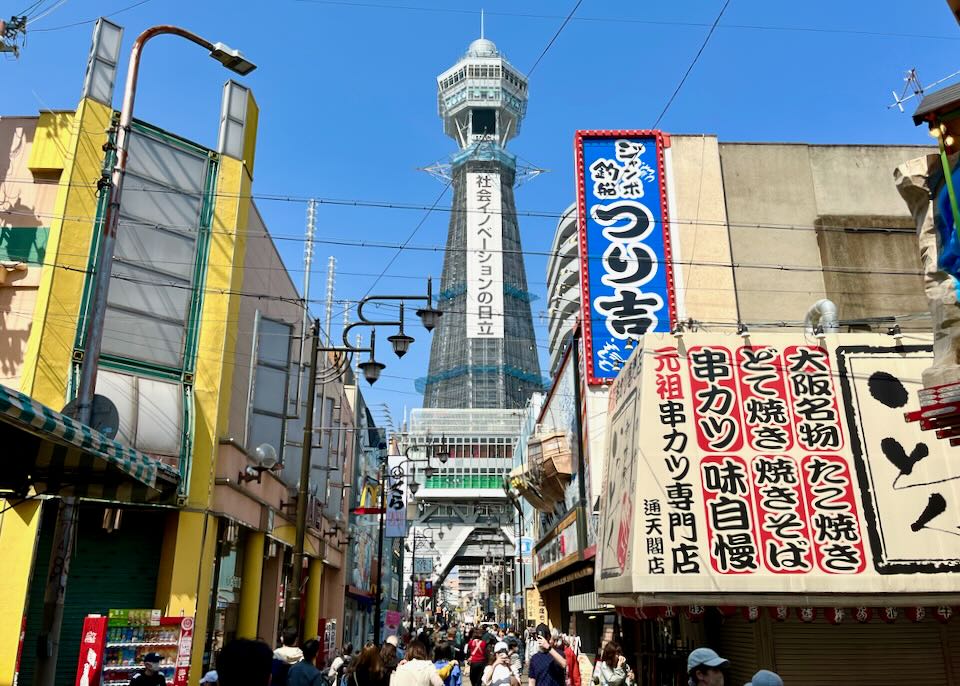
Tsūtenkaku Tower with fabulous views from its observation deck in Shinsekai.
The Best Areas to Stay in Osaka
Osaka is Tokyo’s hip but slightly edgier older brother. Its appeal has boomed in recent years, with grand architectural projects, the country’s biggest castle, nightlife, and some of the best Japanese street food anywhere. It even has its own dialect of Japanese (“Osaka-ben”). Osaka has been an important commercial hub and port for over 2,000 years, and it forms part of the second-largest metro area in Japan.
Osaka Neighborhoods
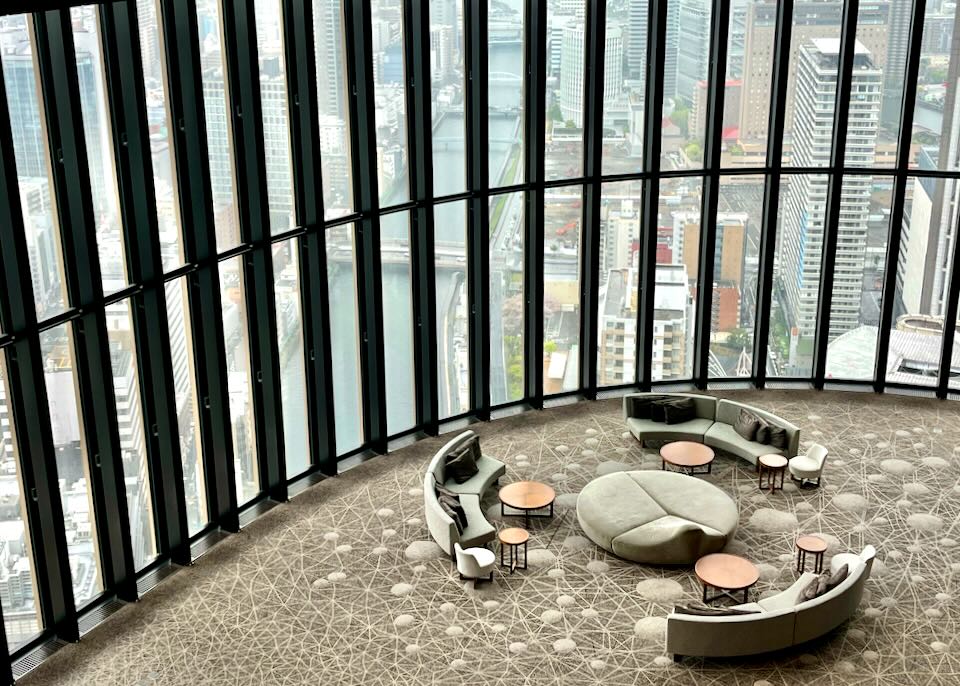
Spectacular views of the city from the the Conrad Hotel located at the top of the Nakanoshima Festival West Tower in Umeda.
Central Osaka is relatively straightforward to navigate, with everything of interest in a series of connected neighborhoods running south from Osaka Station (the main train and subway hub). Umeda (in Kita ward) is a major business and retail hub that includes the futuristic Umeda Sky Building and observatory and the island of Nakanoshima. On the island are the National Museum of Art, the Nakanoshima Museum of Art, and the Osaka Science Museum.
South of Umeda lies Central Osaka/Honmachi, primarily a business district but a convenient base. To the east is the quieter Osaka Castle Area, home to Japan’s largest castle and the Osaka Museum of History, though there are far fewer hotels.
Continuing south from Central Osaka, Minami contains the city’s most fashionable shopping and entertainment districts. There’s the neon-lit Dōtonbori, Amerika-mura, and Nipponbashi Den Den Town, the “otaku” (Japanese pop culture) hub. This is also where you’ll find the city’s premier covered arcades, like Shinsaibashi-Suji Shopping Street and the seafood-rich Kuromon Ichiba (market).
South and east of Minami is Tennōji and lively Shinsekai, an old-fashioned entertainment quarter and another area known for cheap street food. Highlights include the retro Tsūtenkaku Tower, the hot spring baths at SpaWorld, Tennōji Zoo, the observatory on top of Abeno Harukas, and Shitennō-ji temple, Osaka’s premier Shinto shrine.
Tempozan Giant Ferris Wheel at Tempozan Harbour Village
West of the city center lies Osaka Bay, with man-made islands home to Universal Studios Japan, the massive Osaka Aquarium Kaiyūkan, and the Tempozan Giant Ferris Wheel.
Finally, the bullet train (Shinkansen) stops at Shin-Osaka station, 2 miles north of Umeda and Osaka Station. This largely featureless suburb offers cheap, convenient accommodation for those on a short stopover.
Osaka is too big to explore entirely on foot, but there’s an easy-to-use, efficient, and inexpensive public transport system. The overground JR Osaka Loop line is convenient for those using a JR Rail Pass. But Osaka’s extensive subway system with eight lines plus 1 “New Tram” is usually faster. The Osaka Metro 1-Day Pass is a good deal if you intend to pack in a lot of sightseeing (¥620 weekends, ¥820 weekdays). Trains usually have maps and announcements in English.
Safety in Osaka
Parts of Osaka may seem edgier than Kyoto and Tokyo, but it’s generally very safe by international standards. The usual precautions should be taken at night. Dōtonbori and Shinsekai at night can be intimidating with their drinking and nightlife. There is a visibly large homeless population just west of Shinsekai; that’s a little shocking for Japan. Shinsekai is not as dangerous as some Japanese make out, but it’s probably best not to wander around alone late at night, but during the day, it’s fine. Even the redlight district of Tobita Shinchi, south of Shinsekai, is pretty tame, but no photos are allowed at night.
The Best Places to Stay in Osaka
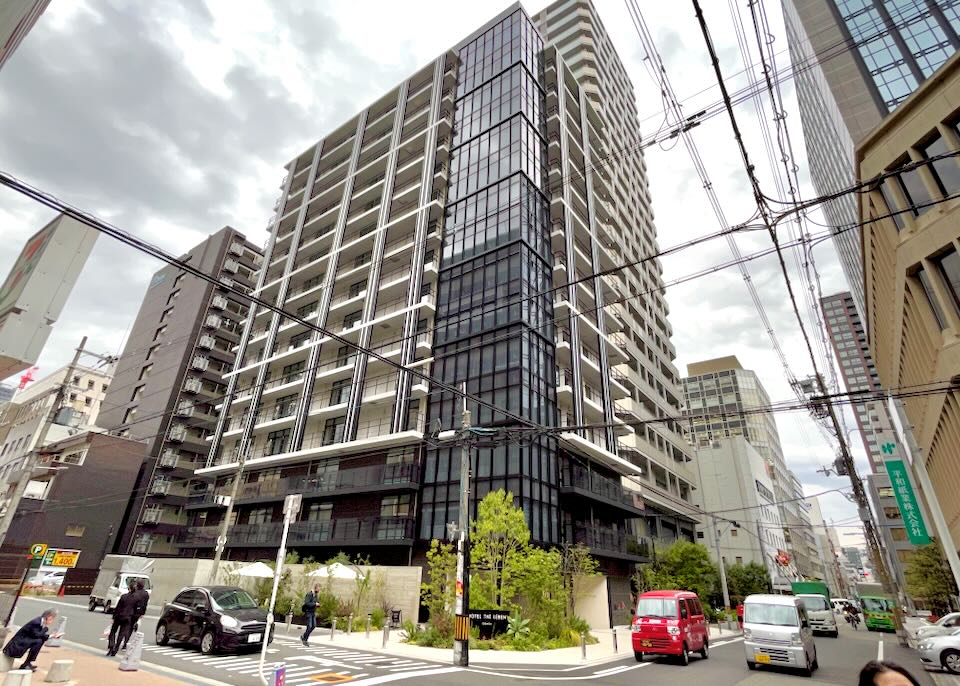
The Leben hotel in Central Osaka/Honmachi.
- Best Luxury Hotels in Osaka
Ritz-Carlton • Conrad • The Leben • Hotel The Flag • Citadines • Mimaru Shinsaibashi East • Mimaru Namba North • Liber Hotel at Universal Studios • Marriott- Best Cheap/Midrange Hotels in Osaka
The Bridge • Willows • Hankyu Respire • Comfort Hotel- Best Hostels in Osaka
The Pax • Feel Osaka Yu • UltraBest Places in Osaka for…
- Best Neighborhood to Stay for First Timers/Sightseeing: Umeda (Kita)
Given Osaka’s size, first-time visitors who intend to see as much as possible should stay in Umeda, preferably near the major transport hubs around Osaka Station. The JR lines and the private Hankyu, Keihan, and Hanshin lines converge here. Umeda Station on the Midosuji subway line is connected to most central areas of interest. Umeda has also developed into a huge shopping and entertainment district (especially near Osaka Station), with vast malls, department stores, and food courts. It’s also home to some of the city’s major sights, including the Umeda Sky Building and the museums of Nakanoshima (Nakanoshima Museum of Art, National Museum of Art, and Osaka Science Museum). Finally, there’s a huge range of accommodation here, in every price range. Having said that, Minami/Namba makes an excellent alternative – if you’re primarily interested in Osaka’s street food and nightlife, stay in this more southerly city section.- Most Romantic Neighborhood: Osaka Castle Area
Cherry Blossom trees in Osaka Castle Park.
There are plenty of romantic things to do in Osaka, like taking river boat trips, enjoying night views from sky-high Harukas 300, and riding on the Hep Five Ferris wheel. But there’s no specific romantic neighborhood. Staying near Osaka Castle Park is a good idea. It’s much quieter in this part of town at night (though you’re not far from the action by subway or taxi), and the park is a beautiful space full of gardens, cherry blossoms, canals, and ancient monuments. Osaka Castle is the most iconic sight in the city and makes a spectacular backdrop to picnics or evening strolls (it’s lit up at night). Get a room with a view of the castle and the park at New Otani.
- Best Neighborhood for Nightlife: Dōtonbori (Minami)
Osaka has a thriving nightlife, but for first-timers, the best place to start is Dōtonbori in the southern Minami area. Pedestrianized Dōtonbori-dōri near Ebisu-bashi Bridge (over the Dōtonbori canal) is the epicenter with late-night food stalls, restaurants, and bars. Check out Hozen-ji Yokochō, a narrow alley of watering holes south of the main strip (okonomiyaki specialist Hozenji-yokocho Yakizen is here). It’s worth seeking out Milk Bar a few blocks north of the canal for its speakeasy vibe, cocktails, and hip background music, or Moonshine Karaoke Bar if you like to sing. Crystal Bar is popular with expats and tourists, while Bar Fun is small but offers tasty cocktails and a decent whisky collection. Fun nightclubs include Club Life Osaka, Club Under, Ghost, and Pure.- Best Neighborhood for Food and Restaurants: Minami
Prepping sea urchin at the Kuromon Ichiba (market).
There’s plenty to eat in the northern half of the city, and Shinsekai is excellent for street food, but overall, Minami is the best place to experience Osaka’s celebrated food culture. Trawling the stalls in Kuromon Ichiba (market) is an essential Osaka experience (though it can get packed during weekends and holidays), with fresh snow crab, sea urchin, pike conger eel (hamo), the notorious fugu (blowfish), and all sorts of shellfish on offer.
Octopus balls at Takoyaki Wanaka in Namba.
In nearby Dōtonbori, famous stalls and restaurants are serving Osaka classics. Try Ajinoya, Chibo, Mizuno, and Hozenji-yokocho Yakizen for okonomiyaki; Dotonbori Imai for udon and soba noodles; Takoyaki Kukuru and Takoyaki Juhachiban for octopus balls; Kushikatsu Daruma for deep-fried kushi-katsu snacks; and Kani Doraku for crab. There’s also Marufuku Coffee, an old-school kissaten (café) since 1934.
Pork buns from Futami no Butaman’s stall in Namba (Minami).
In Namba, try no-frills Kidatake for udon, Rikuro’s famous cheesecake, Futami no Butaman for Chinese-style pork buns (“butaman”), 551 Horai for dumplings, and Takoyaki Wanaka for sumptuous grilled octopus balls. At the pricy end, Osaka boasts plenty of kaiseki (fixed-menu) restaurants, and Osakan kappo-style (seasonal fine dining). Highlights include Asai Togei, tiny Momen, and Shimanouchi Ichiyo. Hitoshi Takahata’s Taian has 3 Michelin stars thanks to his French-Japanese fusion seasonal menus.
- Best Neighborhood for Shopping: Umeda/Kita and Minami
Osaka is a great shopping destination – much of the city feels like a huge marketplace. Osaka Station in Umeda/Kita is at the center of a vast web of shopping malls and giant department stores, beginning with Osaka Station City and Grand Front Osaka malls. The massive Yodobashi Camera Store is an electronics, camera, and computer nirvana. For department stores, check out Hankyu, Daimaru, and budget Don Quijote. On the eastern side of the district, Tenjinbashi-suji Shopping Street is Japan’s longest-covered arcade.Minami has several miles-long “shotengai” (covered shopping arcades) like Shinsaibashi-Suji Shopping Street and Ebisu Bashi-Suji Shopping Street, as well as Sennichimae Doguyasuji Shopping Street for kitchenware.
Shops in Amerika-mura.
The Amerika-mura district is famous for second-hand American clothing and hip fashions. Nipponbashi Den Den Town is home to old-school electronic shops, manga (Japanese graphic novels), anime (Japanese animation), character goods, and cosplay. In Shinsaibashi, Mido-suji (street) is lined with high-end boutiques, while Namba is home to Takashimaya Department Store and another huge underground mall.
- Best Neighborhood for Local Vibe: Shinsekai
Try breaded deep-fried meat and veggies skewers known as kushi-katsu at Kushikatsu Daruma restaurant in Shinsekai.
Shinsekai is an old-fashioned district with narrow streets and alleys filled with cheap food stalls, pachinko parlors, and cheap izakayas (Japanese bars). It’s anchored by Tsūtenkaku Tower, first built in 1912 as part of an amusement park, but the current tower was rebuilt in 1956. Do as the locals do and troll the streets for snacks. Try legendary Kushikatsu Daruma restaurant for kushi-katsu (deep-fried meat and veggies on skewers) or other local favorites like Yakko or Yaekatsu. Get a cheap sushi fix at Taikosushi Minami. Grab a stool at Tengu, an izakaya (bar) in another covered alley specializing in kushi-katsu (look for the red-faced demon with a long nose outside). Or head over to The Pax Hostel, which doubles as a hip café and record shop.
- Best Neighborhood for Families: Osaka Bay
There are family-friendly attractions all over Osaka. Kids Plaza, a huge hands-on science and educational complex in Kita, and Osaka Castle and park are always fun for kids, but Osaka Bay packs the biggest punch. At the top of the list is Universal Studios Japan, a major outpost of the US movie-based theme park franchise. The Wizarding World of Harry Potter is here, and Universal City Walk shopping mall. Across the Aji River is Tempozan Harbour Village, a mall with LEGOLAND Discovery Center Osaka (for kids 3-10 years old), Osaka Aquarium Kaiyūkan, and Tempozan Giant Ferris Wheel. It’s easy to make day trips here from the city center via train or subway, but there are plenty of hotels in the neighborhood, especially around Universal Studios. The best family hotels are Park Front Hotel at Universal Studios at Universal Studios Japan and Universal Port Vita.

The Imperial Hotel on the banks of the O River.
The 7 Best Neighborhoods in Osaka for Tourists
1. Umeda (Kita)
Ted Hyber, a giant green teddy bear sculpture outside Osaka Station.
Umeda, part of Kita or the “North” ward of Osaka, is the northern section of the city center, home of Osaka Station, and the hub for private railway companies. The area around the Station has lots of shopping, including Grand Front Osaka, Hankyu Department Store, and Yodobashi-Umeda electronics department store, all linked by overhead walkways. Close to the station, fans should check out the Pokémon Center Osaka and public works of art like the Izumi-no-Hiroba (shiny tree sculpture) and Ted Hyber, the giant green teddy bear sculpture. The Hep Five Ferris wheel offers a birds-eye view of the action that’s incredibly vivid at night.
Umeda includes Nakanoshima, a 2-mile (3.2km) island with skyscrapers and stylish shopping malls. The island contains several museums, including the Museum of Oriental Ceramics, the National Museum of Art (focusing on Japanese and international contemporary art since World War II), the stylish Nakanoshima Museum of Art (contemporary and modern art from around the world), and the family-friendly Osaka Science Museum, with its interactive displays. The Osaka International Convention Center lies at the western end of the island.
One view of the city from the Kuchu Teien Observatory.
To the north, the Kuchu Teien Observatory sits atop the futuristic Umeda Sky Building. Two structures with glass escalators between them move guests up the 568 feet (170 meters) to the top.
Looking down from the Kuchu Teien Observatory at the glass escalators that ride up the Umeda Sky Building.
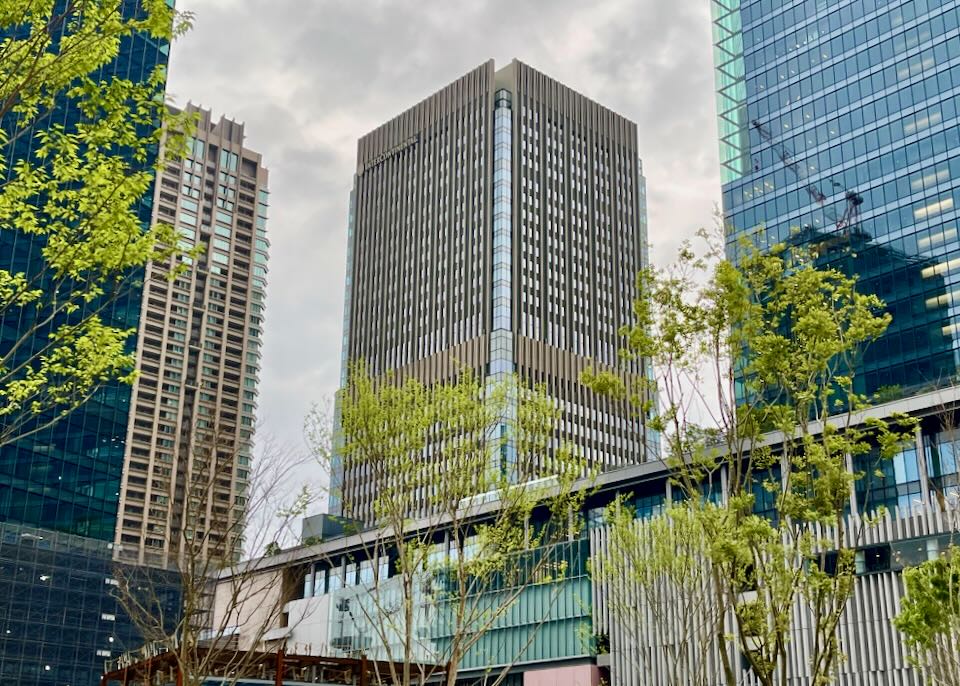
InterContinental Osaka.
- The Best Hotels in Umeda (Kita):
InterContinental Hotel phone: +81 66 374 5700
Conrad Hotel phone: +81 66 222 0111
Imperial Hotel phone: +81 66 881 1111
Ritz-Carlton Hotel phone: +81 66 343 7000
Westin Hotel phone: +81 66 440 1111- Best Cheap/Midrange Hotels:
Boly Hotel phone: +81 66 222 7768
Cordia Hotel phone: +81 66 449 2030
Guesthouse U-en Hotel phone: +81 67 503 4394
Hankyu Respire Hotel phone: +81 66 372 8006- Best Hostels:
OGK Hotel phone: +81 66 453 0177
Rota Hotel phone: +81 64 804 90012. Central Osaka/Honmachi
Central Osaka.
South of Umeda and the Tosabori River is Central Osaka, comprised of the Honmachi neighborhood and Semba business/financial district. It doesn’t have the attractions of other areas, but it’s a convenient base packed with reasonably-priced hotels and some great restaurants and bars. Visitors with kids might want to check out the free science exhibits at the OSTEC Exhibition Hall or let off some steam in Utsubo Park.
Just south of Honmachi Station is the Namba Jinja, a tranquil Shinto shrine known for its cherry blossoms and 400-year-old camphor tree. Not be confused with the Namba Yasaka Jinja further south, known for its giant lion’s head over the entrance.
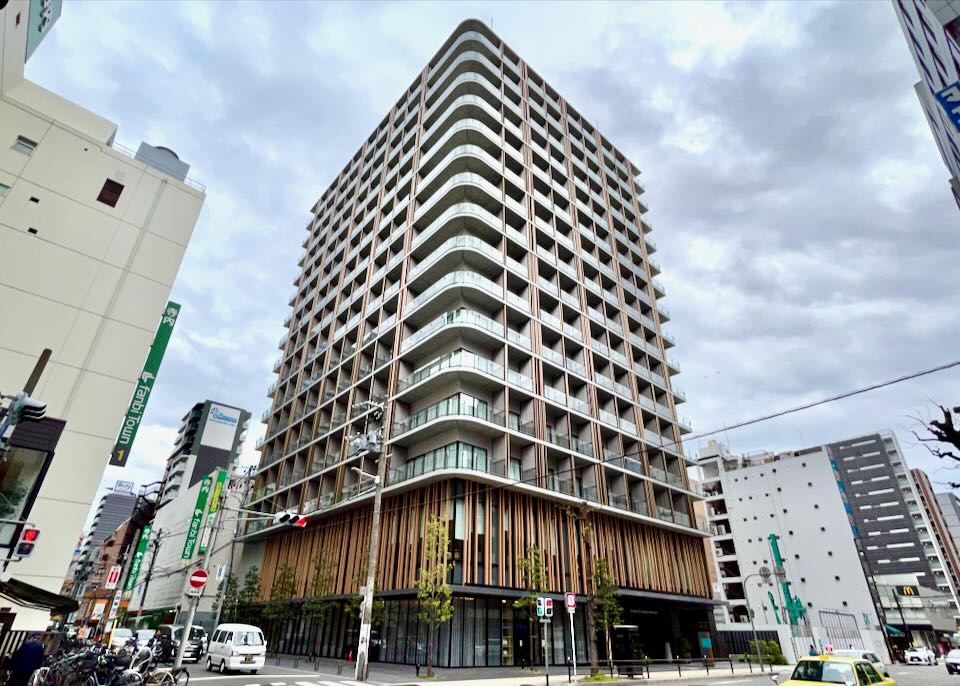
Miyako City Osaka Hommachi hotel.
You’ll find many excellent mid-range hotels and a few luxury names here. The central location makes it a good base for longer visits to the city.
- The Best Hotels in Central Osaka/Honmachi:
The Leben Hotel phone: +81 66 263 1111
MIMARU North Hotel phone: +81 64 708 7852
Miyako City Hotel phone: +81 66 263 0385
St. Regis Hotel phone: +81 66 258 3333
W Hotel phone: +81 66 484 5355- Best Cheap/Midrange Hotels:
Cordia Hotel phone: +81 64 256 2323
Yururito Hotel phone: +81 66 585 7222
Dormy Inn Premium Hotel phone: +81 66 201 5489
Travelodge Hotel phone: +81 64 963 2196
Vine Hotel phone: +81 64 256 3690
&And Hostel Hotel phone: +81 66 944 17773. Minami/Namba
The Dōtonbori Canal.
Central Osaka’s southern section is Minami, meaning “south.” It’s old-school Osaka, a little edgier than anything you’d see in Tokyo, and lots of fun. It’s an excellent base for shopping and nightlife. While you wander, you can sample some of Japan’s best street food in a tradition called “tabe aruki,” translating to “eat while you stroll.”
There are many shopping opportunities in Minami in the districts of Shinsaibashi, Dōtonbori, Nipponbashi Den Den Town, and Namba. Plus, the vintage U.S. clothing shops in the Amerika-mura area. Covered Shinsaibashi-Suji Shopping Street runs south from Shinsaibashi Station to the neon-smothered Dōtonbori nightlife district. There, you can see the famous 1930s “Glico” Sign and the giant crab over the entrance to the Kani Doraku restaurant.
From here, the covered Ebisu Bashi-Suji Shopping Street continues south for several blocks into the heart of Namba, another major nightlife and shopping micro-district. Find the vast underground Namba City shopping mall and Takashimaya Department Store here.
The Kani Doraku restaurant and giant crab.
Just east of Namba lies one of the city’s biggest attractions, the Kuromon Ichiba (market). Besides fruits, vegetables, meats, and sweets, it sells fresh and cooked seafood with delicacies like snow crab, sea urchin, eel, sushi, and all sorts of shellfish. Plus, the most sought-after pike conger eel (hamo) and the potentially deadly blowfish (fugu).
A woman uses a blow torch to cook seafood at Kuromon Ichiba.
The most famous stalls attract long lines, and it gets crowded on weekends and holidays. In the middle of the market is a public space with restrooms and tables where you can eat your goodies.
A bit further south, Sennichimae Doguyasuji Shopping Street is known for kitchenware. Nipponbashi Denden Town is similar to Tokyo’s Akihabara, dedicated initially to electronic goods. Now, it’s famous for shops specializing in manga (Japanese graphic novels), anime (Japanese animation), character goods, and cosplay. It’s also home to numerous “maid cafes” like Maidreamin. Most of the area’s 500 stores are along Sakaisuji-dōri (avenue) and its side streets.
Other highlights include the National Bunraku Theatre. It’s the best place to see traditional Japanese puppet performances, with productions about five times a year. Osaka’s famous Yoshimoto Kogyo comedy shows are at Namba Grand Kagetsu Theater, but they are performed in Japanese and may be challenging to appreciate unless you speak the language.
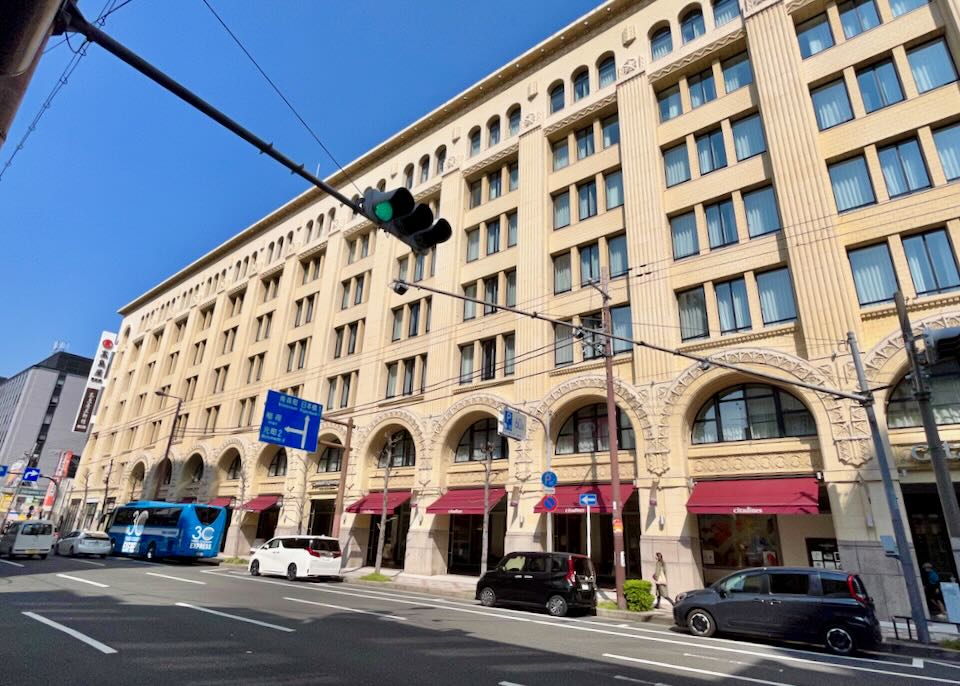
The Citadines Hotel.
The best reasonably-priced hostels in the city are here. The area lacks a good selection of budget and mid-range hotels as rates tend to be on the high side.
- The Best Hotels in Minami/Namba:
Hotel The Flag Hotel phone: +81 66 121 8111
Citadines Hotel phone: +81 66 695 7150
Mimaru East Hotel phone: +81 64 256 4010
Mimaru North Hotel phone: +81 66 648 8730
Swissotel Nankai Hotel phone: +81 66 646 1111- Best Cheap/Midrange Hotels:
The Bridge Hotel phone: +81 64 963 6501
Hotel Forza Hotel phone: +81 66 214 3111- Best Hostels:
Feel Osaka Yu Hotel phone: +81 50 5241 6291
Mitsuwaya Hotel phone: +81 66 711 0818
Poly Hotel phone: +81 66 710 9901
Imano Hotel phone: +81 66 534 0088
Picnic Hotel phone: +81 66 567 7400
Ultra Hotel phone: +81 80 4937 13864. Tennōji/Shinsekai
The entrance to Shinsekai.
Southeast of Minami lies Shinsekai and Tennōji. Shinsekai is an old-fashioned entertainment quarter that harks back to pre-World War II days. It’s another great place for cheap street food, especially for octopus fritters (takoyaki), blowfish (fugu), and all sorts of deep-fried “kushi-katsu” snacks.
Billiken sits outside the Kushikatsu Viking Daitoryo restaurant, a buffet of fried food on a stick.
The area is anchored by Tsūtenkaku Tower, built in 1956, with fabulous views from its observation deck. Look for “Billiken,” the area’s good luck monkey-like mascot. Rub the soles of his feet to make wishes come true. Find him throughout the area on souvenirs, statues, and his shrine.
If you need a break, head to SpaWorld, one of Japan’s largest indoor hot springs (onsen). The baths are internationally-themed with places like Bali, Ancient Rome, Atlantis, and the Blue Grotto Capri. There’s also an indoor waterpark with a kid’s pool, colorful water slides, a sunning terrace, and an outdoor Jacuzzi overlooking Tsūtenkaku Tower.
Tennōji Park.
Shinsekai borders Tennōji Park (Tennōji-kōen), home to Tennōji Zoo with more than 1,000 animals, a couple of temples, and the Osaka City Museum of Fine Arts (recently reopened after major renovations). Looming over the park is the tallest building in Osaka, Abeno Harukas. At 984 feet (300m), it contains Kintetsu Department Store, a Marriott hotel, and the Harukas 300 observation deck with sensational regional views. Go early on clear days to avoid long lines.
Shitennō-ji pagoda.
Just to the northeast of Tennōji Park stands Shitennō-ji temple, the spiritual heart of Osaka. It’s more than 1,400 years old and is the first and oldest temple in Japan. It’s been faithfully reconstructed to its 6th-century grandeur after being destroyed during the siege of Osaka in 1615 and again in World War II. The five-story Buddhist pagoda has a vast main hall and a Japanese-landscaped garden. Also worthwhile is the flea market held on temple grounds on the 21st and 22nd of each month.
Turtles in a pond outside the Shitennō-ji complex.
Fans of traditional Japanese architecture and culture should check out the ancient Shinto shrine of Sumiyoshi Taisha. It’s over 1,000 years old but has been rebuilt many times. It’s about 2.5 miles (4km) south of Tennōji Station and around 20 minutes by train.
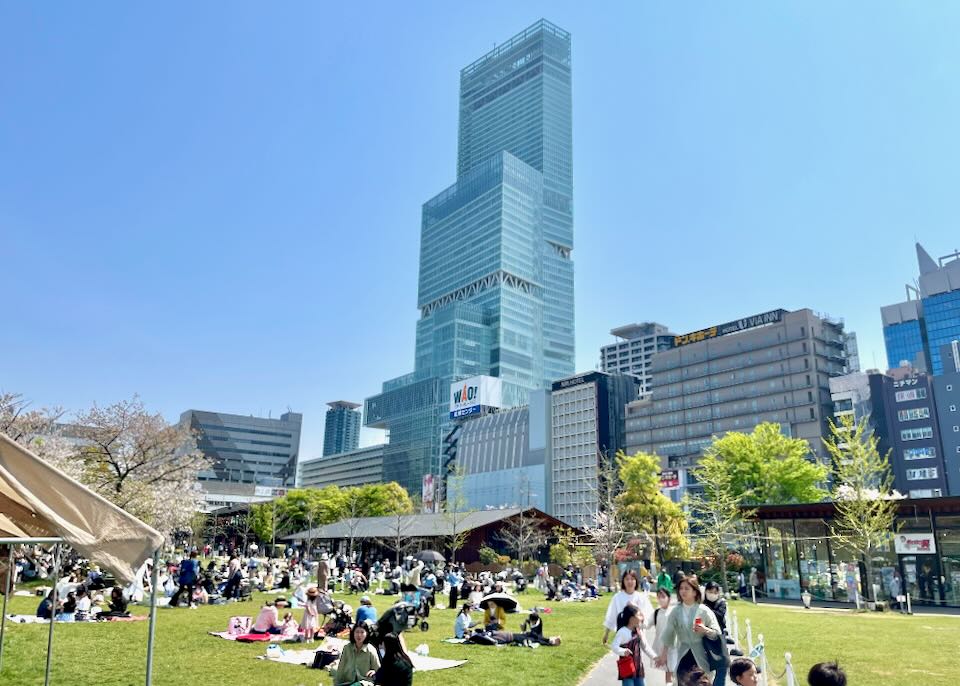
On the top floors of the tall Abeno Harukas building is the Osaka Marriott Miyako Hotel with direct access to Tennoji Station and across from the park.
There are many cheap hotels here, but they tend to be poor quality, with exceptions noted below. You’ll find some good hostels and decent mid-range options.
- The Best Hotels in Tennōji/Shinsekai:
Marriott Hotel phone: +81 66 628 6111
ESLEAD HOTEL Namba South III Hotel phone: +81 66 632 8727- Best Cheap/Midrange Hotels:
Reikyo Garden
Willows Hotel phone: +81 66 630 7535
Guest House Matsu Hotel phone: +81 66 658 0202- Best Hostels:
Mad Cat Hotel phone: +81 80 9976 4079
The Pax Hotel phone: +81 70 3899 3605
04village Hotel phone: +81 66 599 9704
Cocoroom Hotel phone: +81 66 636 16125. Osaka Castle Area
Osaka Castle.
The historic heart of the city lies east of Central Osaka/Honmachi. The area is anchored by Osaka Castle, Japan’s biggest and most famous castle – even though it’s a reconstruction. Surrounded by an expansive park famous for its cherry trees, this is one of Osaka’s top attractions. Go early to avoid long lines if you intend to go inside.
Warlord Toyotomi Hideyoshi started building the castle in the 1580s, but Shogun Tokugawa Ieyasu demolished it after he captured it in 1615. It’s been rebuilt several times since then, most recently in concrete after World War II. The Main Tower is a high-tech museum that describes the castle’s history and displays swords and other artifacts, with a full-scale reproduction of the Gold Tea Room. The views from the top deck are a bonus.
A photo at the Osaka International Peace Center shows the aftermath of the 1945 bombing.
Other highlights include the newish Osaka Museum of History. There are three floors of exhibits charting the city’s history up to 1945, and it has fantastic views of the castle. Some labels are in English. A short walk away is the Osaka International Peace Center, which commemorates the eight deadly “Great Osaka Air Raids” that effectively leveled the city in 1945. The bombs killed more than 10,000 civilians. There are downloadable brochures in English.
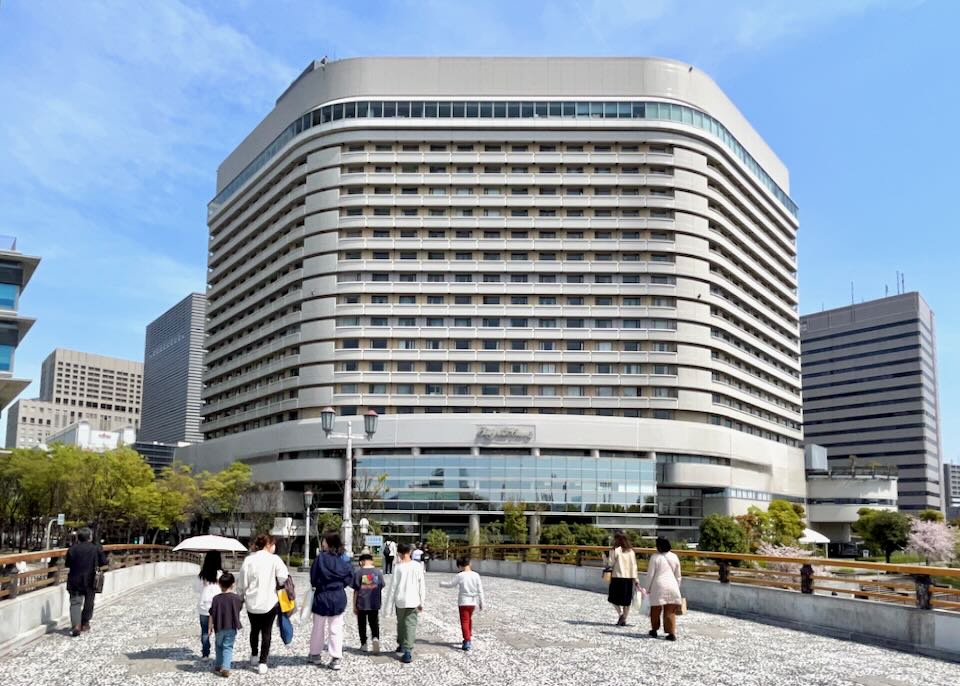
New Otani Hotel.
There are only a few accommodations around the castle, which tend to be quieter.
- The Best Hotel in the Osaka Castle Area:
New Otani Hotel phone: +81 66 941 1111- Best Cheap/Midrange Hotels:
The Lutheran Hotel phone: +81 66 942 2281
Luxcare Hotel phone: +81 66 946 7352- Best Hostel:
Furoya Hotel phone: +81 70 1543 55806. Osaka Bay
Universal Studios Japan.
On the western edge of the city is Oskaka Bay. The once industrial area around Osaka Port has emerged as a series of pleasant waterfront districts. It’s different from the rest of the city because it’s new, close to the water, and popular with families. But it’s not “traditional” Osaka. There are three main areas of interest: Universal City, Tempozan Harbour Village, and the Sakishima Cosmosquare Area.
Universal City is home to Universal Studios Japan, an outpost of the US movie-based theme park franchise. There’s the Wizarding World of Harry Potter, Universal City Walk shopping mall, Zepp Osaka Bayside live concert venue, and a collection of hotels. It has its own train station with frequent service to the city center.
Osaka Aquarium Kaiyūkan.
On the other side of the Aji River is Tempozan Harbour Village. Part of the mall contains LEGOLAND Discovery Center Osaka for kids 3–10 years old. There’s Japan’s best aquarium, Osaka Aquarium Kaiyūkan, showcasing 15 different Pacific Ocean habitats. And the Tempozan Giant Ferris Wheel. If coming from Universal City, there’s a free hourly ferry or the Tempozan Bridge. From the City center, it’s connected via subway at Osakako Station.
Sakishima Cosmo Tower.
The Sakishima Cosmosquare Area is one stop further west on the subway. Home to ATC-Asia-Pacific Trade Center and INTEX Osaka convention center. Check out the fabulous views of Osaka Bay from the observation deck at Sakishima Cosmo Tower. On the west end of the island, there’s an excellent natural walking path where migratory birds nest in the Osaka Nanko Bird Sanctuary.
Osaka Bay is a great day trip destination. There are hotels here, but it’s not convenient for exploring the rest of the city, despite good rail and subway links to the center. If you are staying for trade shows, Quintessa is the best place to stay.
- The Best Hotels in Osaka Bay:
Liber Hotel at Universal Studios Hotel phone: +81 66 462 3333
Universal Port Vita Hotel phone: +81 66 460 8000
Park Front Hotel at Universal Studios Hotel phone: +81 66 460 0109- Best Cheap/Midrange Hotels:
Guest House Yadomaru Hotel phone: +81 67 173 0677
Guest House Apple Hotel phone: +81 80 3389 1711
TOMARO Hotel phone: +81 67 509 2126
J-Hoppers7. Shin-Osaka
Shin-Osaka Station.
If you’re traveling by train or Bullet Train (Shinkansen) from Tokyo or Kyoto, you’ll arrive at Shin-Osaka Station. It’s about 2 miles (3.5km) north of Downtown and Osaka Station. Here, you’ll transfer to local trains or the subway to reach the rest of the city.
Though it’s a modern area with nothing to see, it’s convenient to stay here if you have a short stopover while traveling by bullet train. Compared to Downtown Osaka, there are many cheap, decent hotels in the area. You can dump your bags at one of them and start exploring the city by public transport.
A Gassho-zukuri house with a “clasped-hands” thatched roof at the Open-Air Museum of Japanese Farmhouses
It’s also the best base for exploring attractions in Northern Osaka. Some 14 minutes northeast of Shin-Osaka by train, the Asahi Beer Museum occupies the famous beer company’s first factory, built in 1891. Around 25 minutes north of Shin-Osaka (and a 15-minute walk from Ryokuchikoen Station) lies the atmospheric Open-Air Museum of Japanese Farmhouses. See 12 historic wood and thatch buildings from all over Japan, including a rural kabuki theater.
Northeast of here lies the Expo ’70 Commemorative Park. The site of the 1970 World’s Fair, and home of the giant, whimsical Tower of the Sun monument, the National Museum of Ethnology, and the Redhorse Osaka Wheel (Ferris wheel). Further west is the Cup Noodles Museum Osaka Ikeda, and in the mountains, the Minoh Falls.
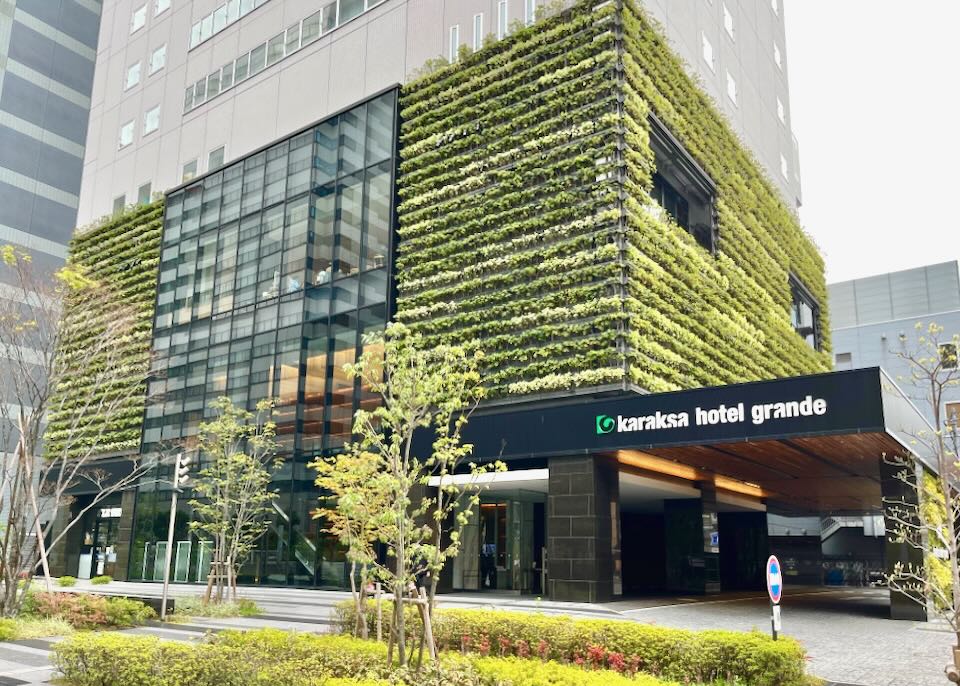
The Karaksa Hotel Grande in Osaka Tower.
- The Best Hotels in Shin-Osaka:
Karaksa Hotel Grande Hotel phone: +81 66 391 6602
Holiday Inn Hotel phone: +81 66 399 5000
Courtyard Hotel phone: +81 66 350 5701- Best Cheap/Midrange Hotels:
Hotel androoms Hotel phone: +81 64 807 5111
Comfort Hotel Hotel phone: +81 66 305 1911
APA Hotel Hotel phone: +81 57 006 0711- Best Hostel:
Shin-Osaka Youth Hostel Hotel phone: +81 66 370 5427Osaka With More Time
With more time, it’s worth heading northeast of Osaka Station to Tenjinbashi-suji Shopping Street, Japan’s longest covered arcade or “shotengai.” Stretching 1.6 miles (2.6km) between Tenjinbashi 6-chome and Ogimachi stations. The covered arcade has about 600 shops selling various goods, attracting primarily local customers. To the south lies Osaka Tenmangū, a revered Shinto shrine founded in the 10th century but most famous for its Tenjin Matsuri festival, held annually July 24–25.
Osaka Travel Tips
- Osaka gets busy during cherry blossom season from late March to mid-April and for the fall foliage season in November. Book hotels months in advance and expect large crowds during these times.
- The bullet train (Shinkansen) only serves Shin-Osaka Station, about 2 miles (3.5km) north of Osaka Station and Downtown. To get into the city center, transfer to the local train or subway.
- Osaka is served by two airports: Kansai International Airport (some 30 miles/50km southwest of Osaka Station, out in Osaka Bay), and domestic Osaka International Airport or Itami (8 miles/13km northwest of Osaka Station). From Kansai, there’s the Kansai Airport Rapid train (just over 1hr to Osaka Station, 45min to Tennoji), and the “Limited Express Haruka” train service to Shin-Osaka and Kyoto. Taxis will charge ¥16,000–19,200 (US$115–135) to Osaka Station, depending on when you arrive. From Osaka Airport, take the monorail to Hotarugaike or Senri-Chuo stations to transfer to the local train and subway network (allow 30–40 minutes to Osaka Station).
- There’s not much point to staying at either airport, given how easy it is to get into the city, but if you need to stay at Kansai, the most convenient option is Hotel Nikko Kansai Airport. The First Cabin Kansai Airport capsule hotel next door is cheaper and adequate for one night, if you’re used to this sort of hotel.
- Don’t rent a car. Parking is expensive, roads can be congested, and driving here can confuse first-timers. Public transportation is excellent in Osaka, and the subway or train will take you within walking distance of almost every attraction.
- Cycling is popular in Osaka. Though the city is relatively flat, it’s large. Docomo operates the city’s bikeshare, with docking stations all over Osaka – day passes are ¥1,527 or around US$10. For English-language bike tours and rental services, contact the friendly folks at Cycle Osaka.
- Though most hotels and some shops and restaurants will have English speakers on hand, don’t assume everyone will understand you. The staff at the main JR Ticket Office at Osaka Station can communicate in English, menus usually have photos you can point at, and signage in the station (and around the city) is translated into English, but try to learn a few words and numbers in Japanese if you can.
- The city operates several tourist information centers: • in front of the central ticket gates of Osaka Station (7am–10pm) • at Shin-Osaka Station (3rd Floor, Central Concourse; 8am–10pm) • and on the 2nd floor of Nankai Namba Station (9am–7pm).
- The Osaka Amazing Pass is a popular tourist discount card, though it’s only worth it if you intend to visit many sights. Some included are the Umeda Sky Building, Hep Five Ferris Wheel, National Museum of Art, Legoland, and Osaka Castle and boat trips. It provides free entry to over 40 museums and attractions and unlimited rides on local trains and buses for ¥2,800 for one day (around US$20) or ¥3,600 for two days (around US$25).
- Free Wi-Fi is available at hotspots throughout the city thanks to “Osaka_Free_Wi-Fi,” but you must register your email to access the service. Osaka Castle is covered, as are most stations and major sights.
- Escalator etiquette: Stand on the right when using escalators in Osaka. Though, it’s conventional to stand on the left in Tokyo and most other cities in Japan – use the left side if you intend to walk.
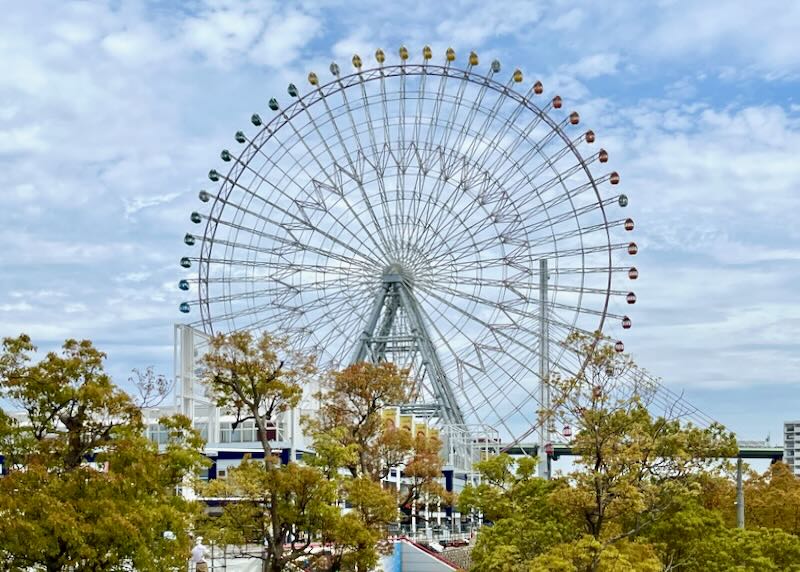

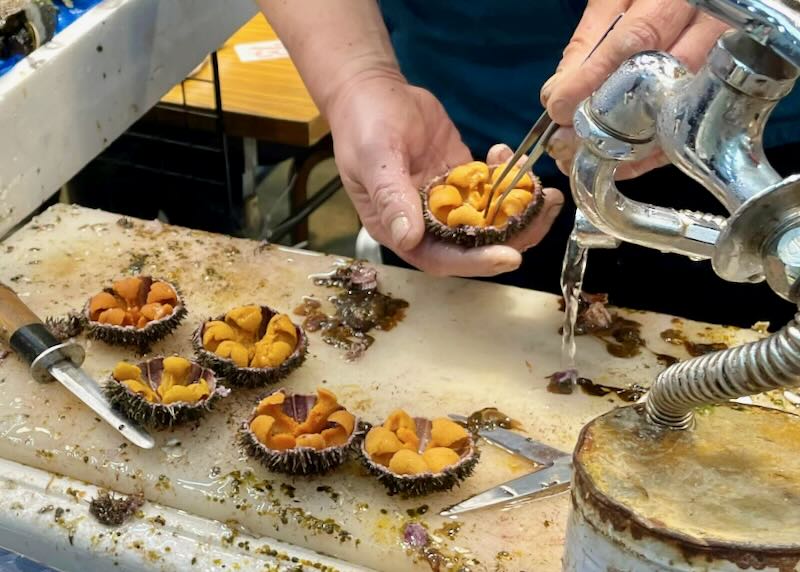
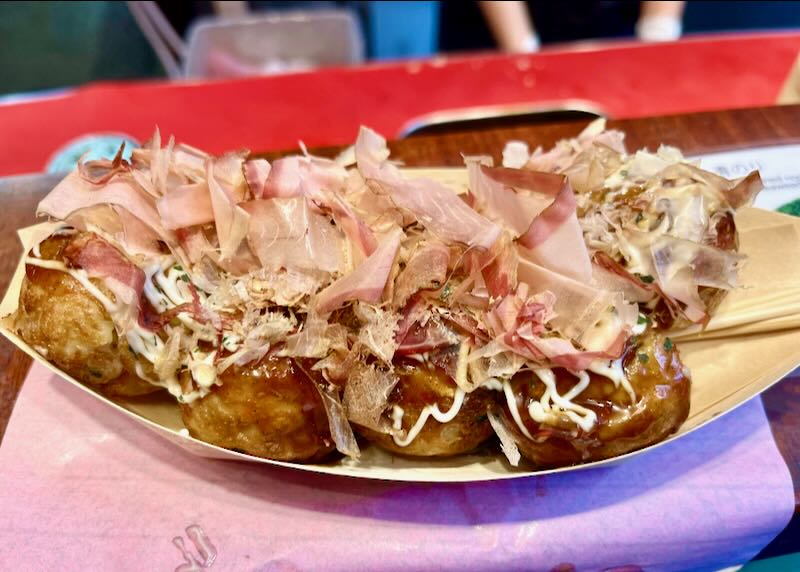
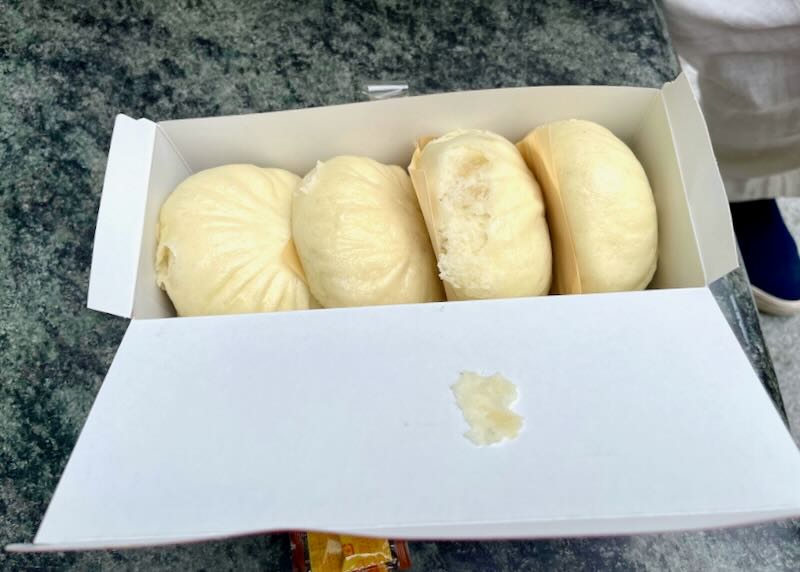
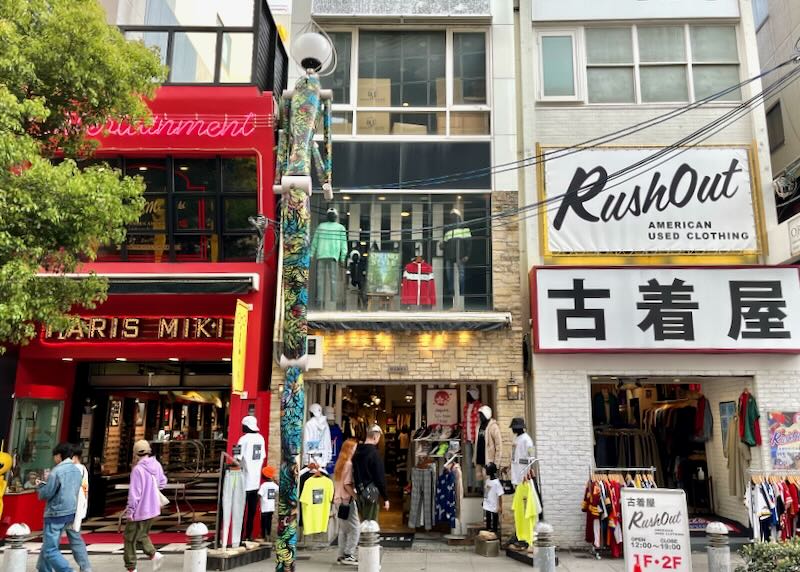
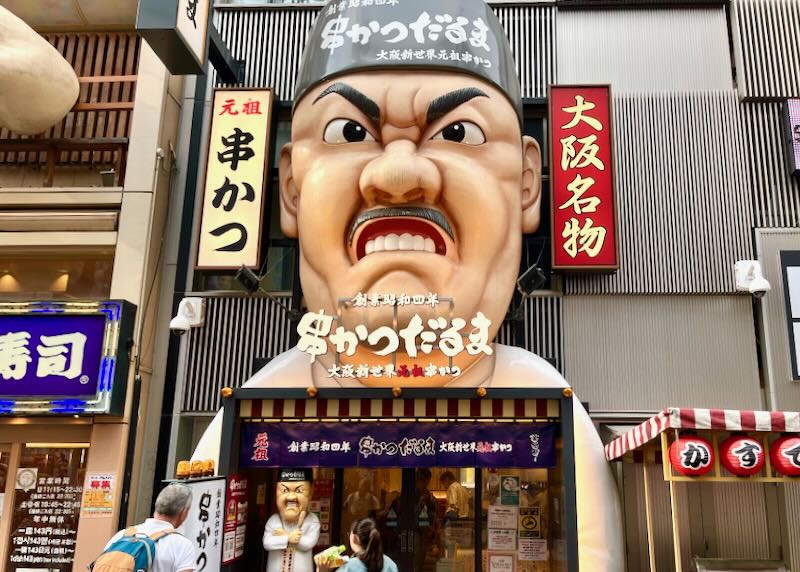
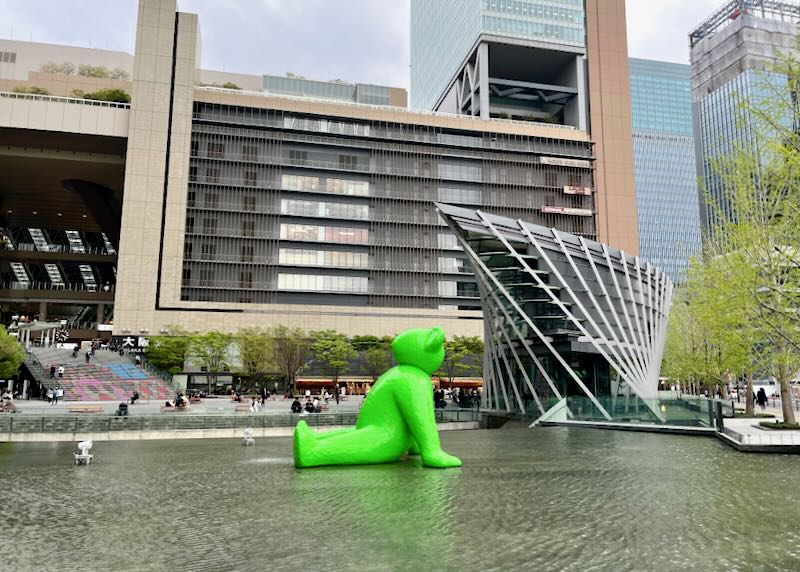
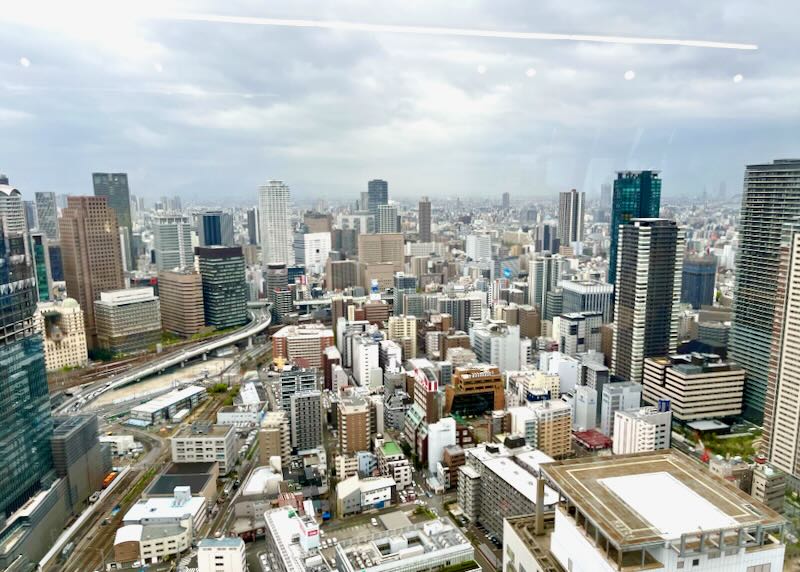


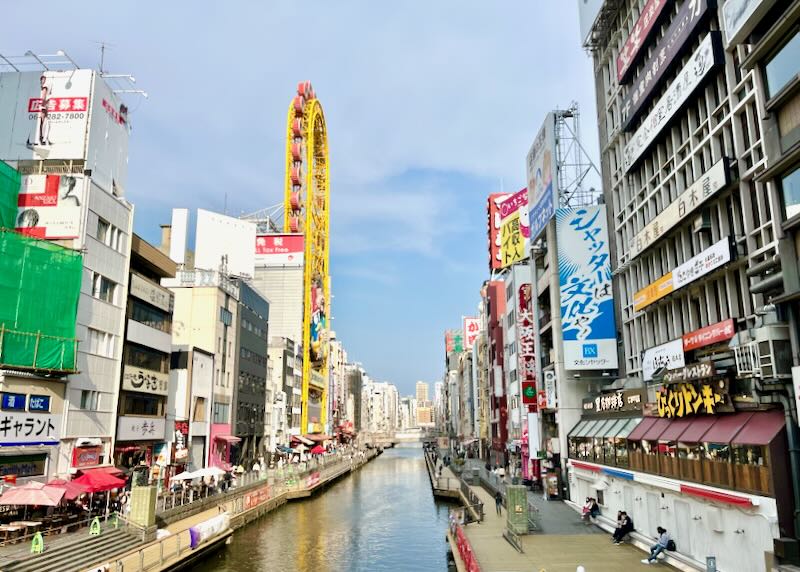
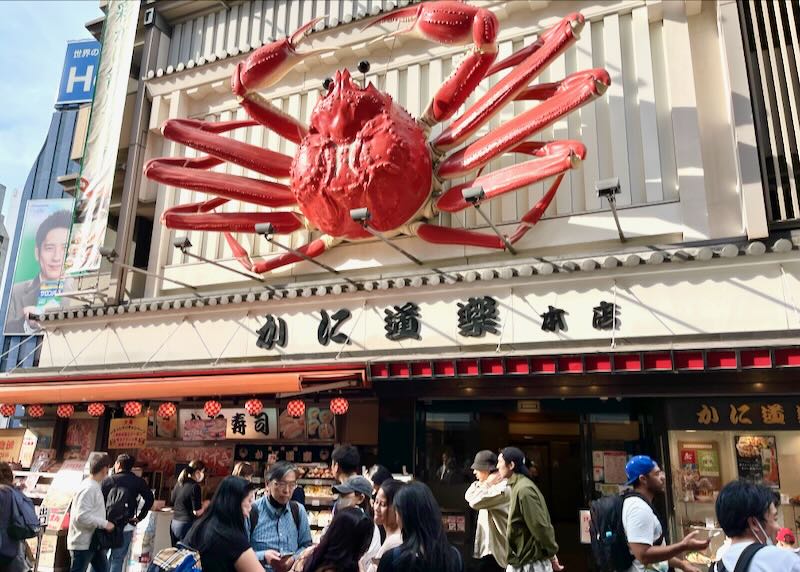

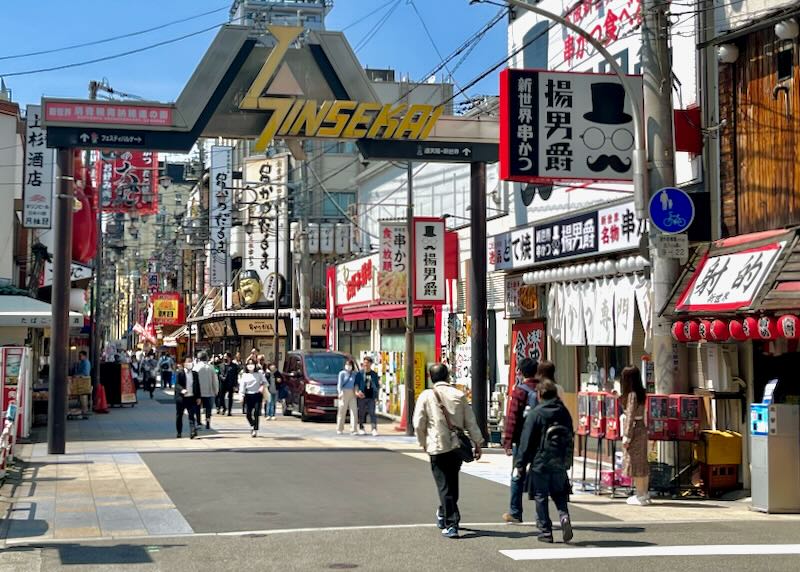
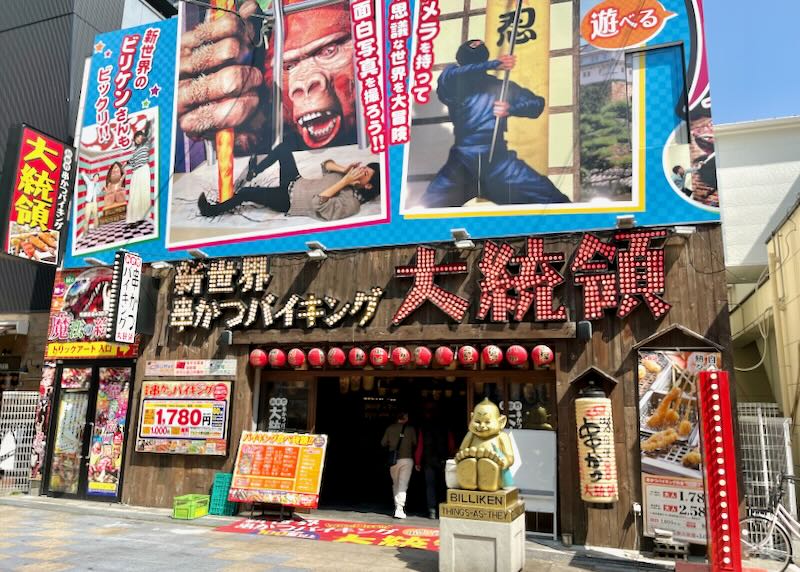
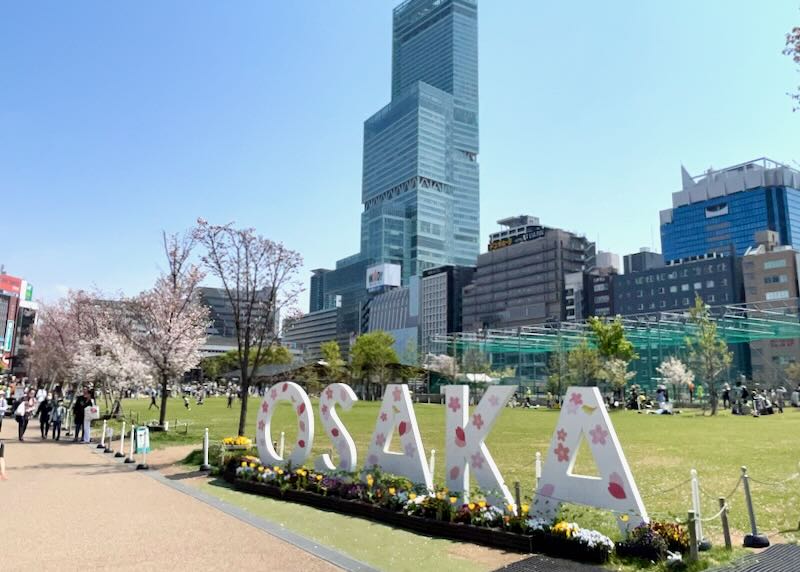
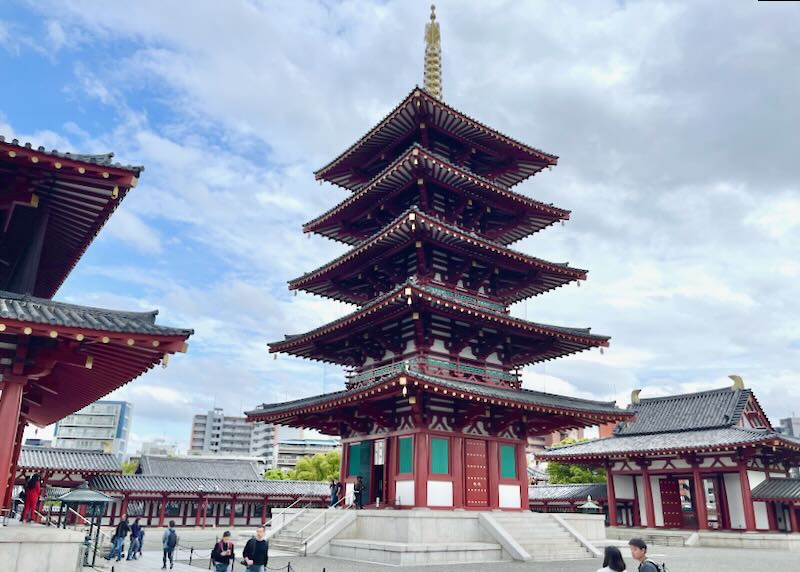
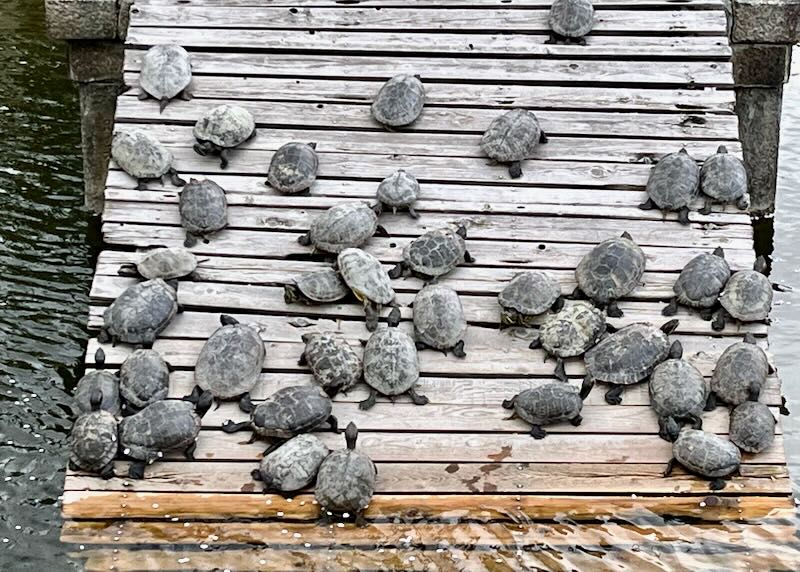
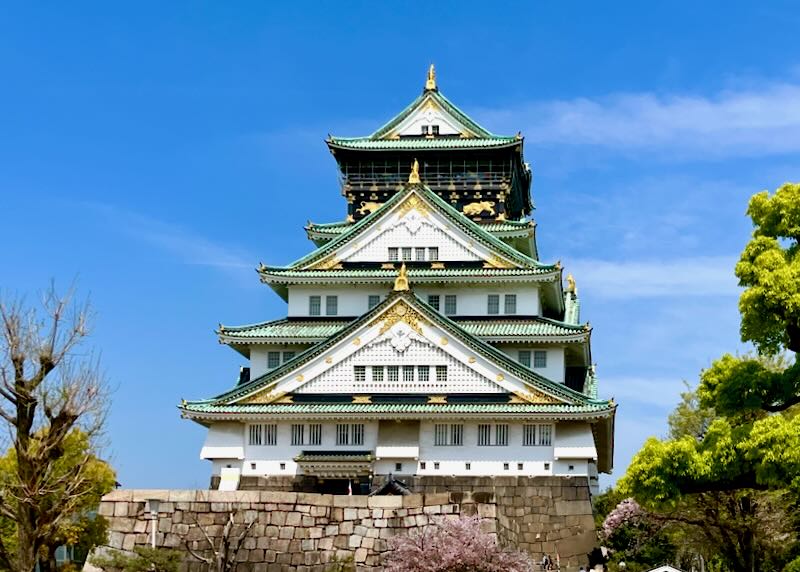
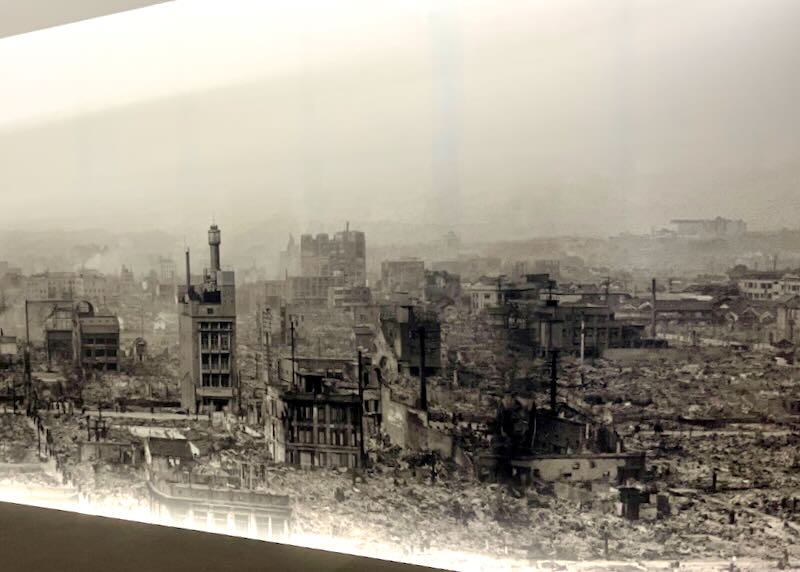
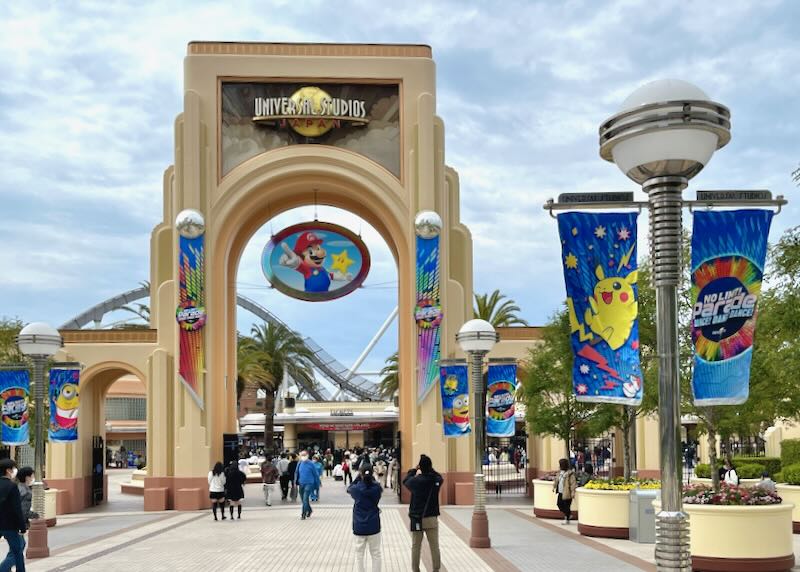
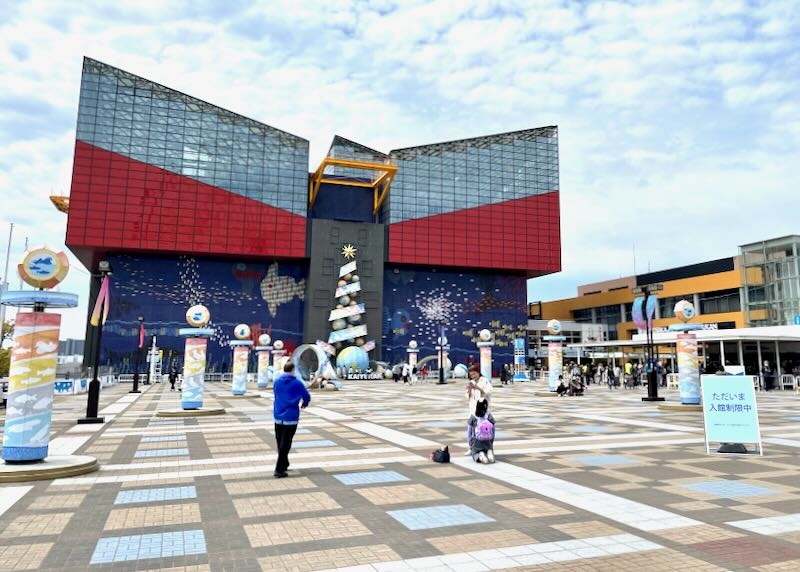
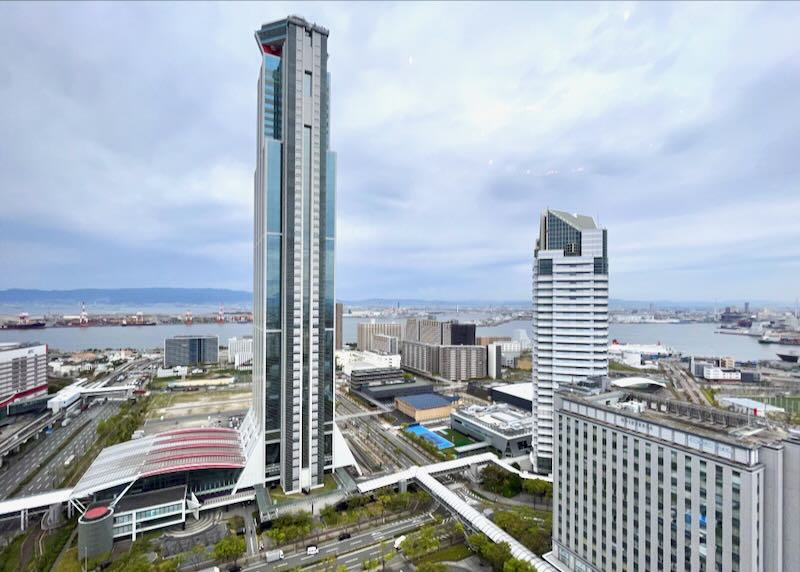
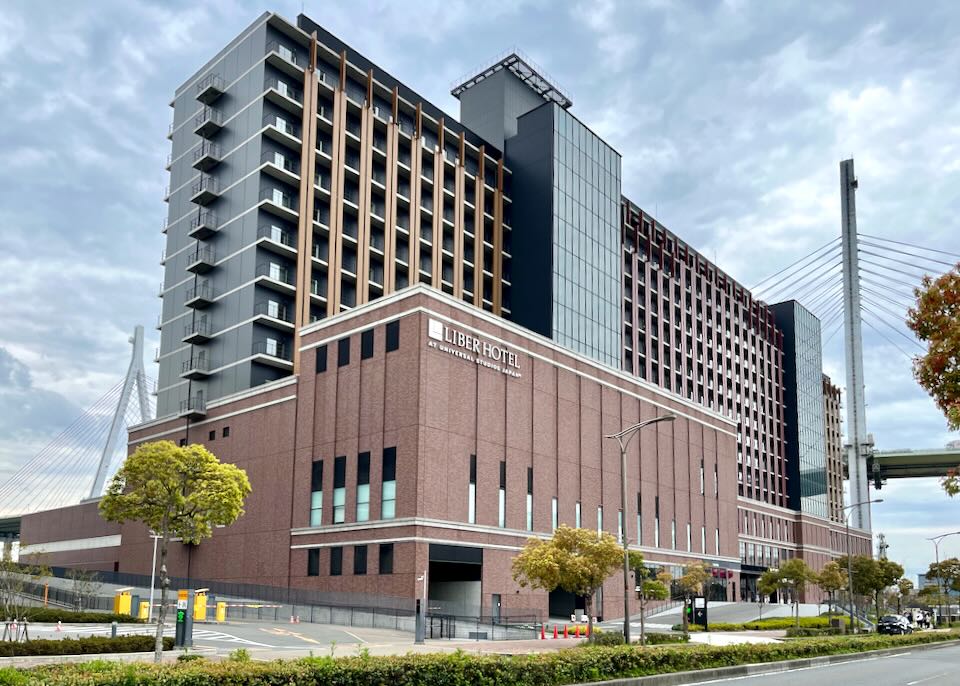
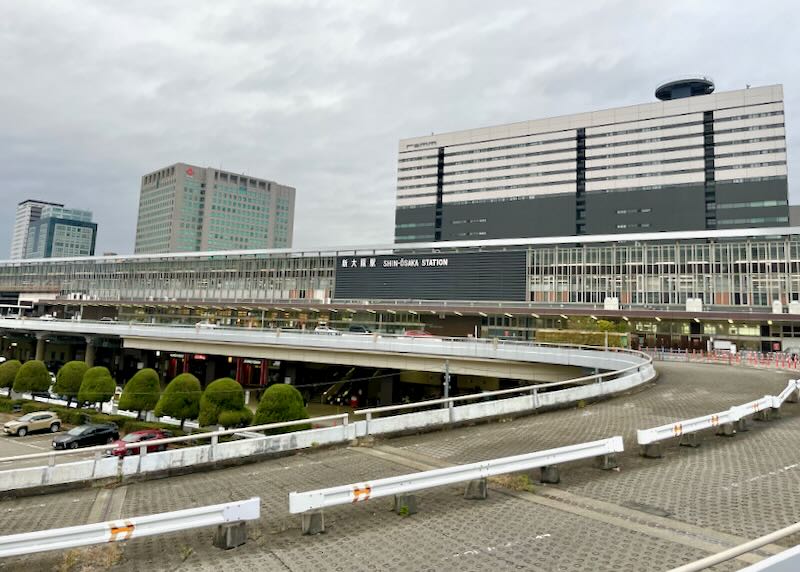
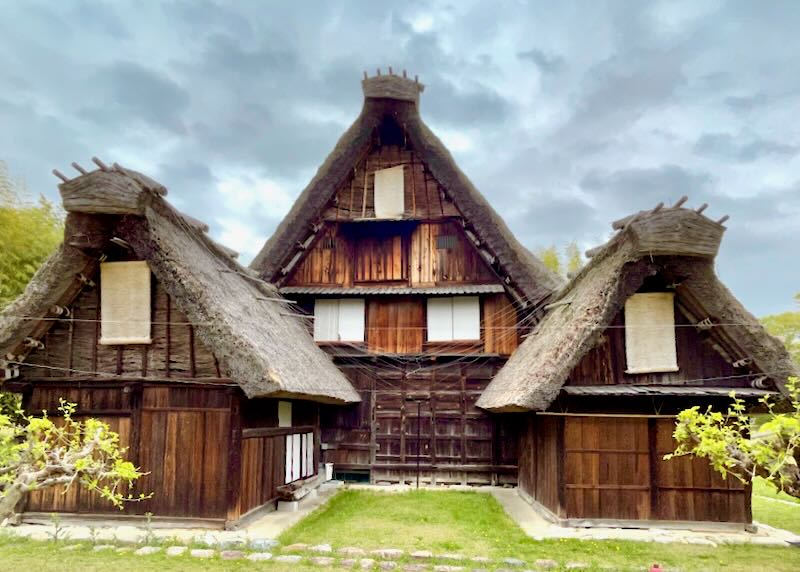
About Santorini Dave